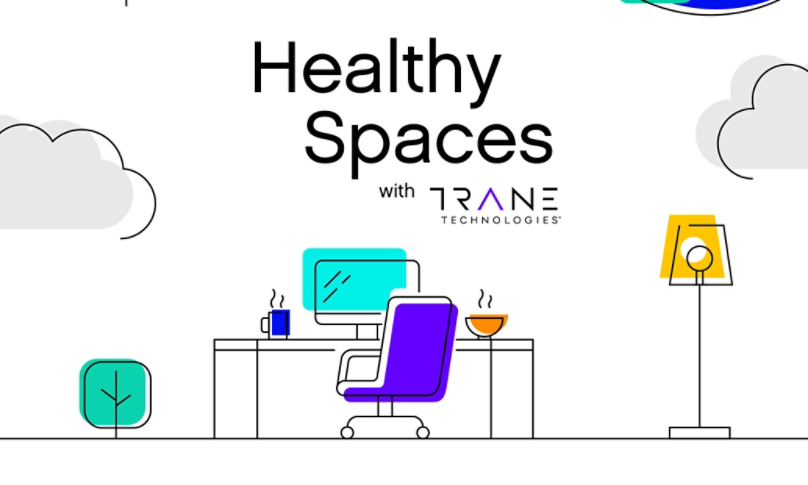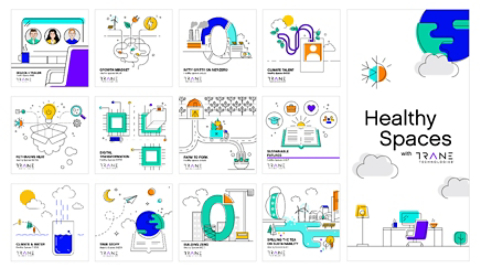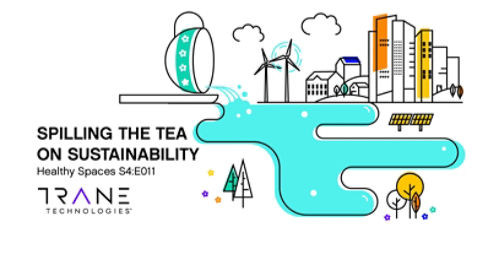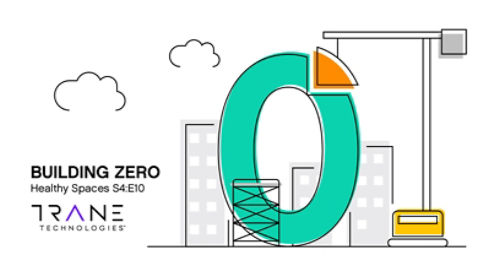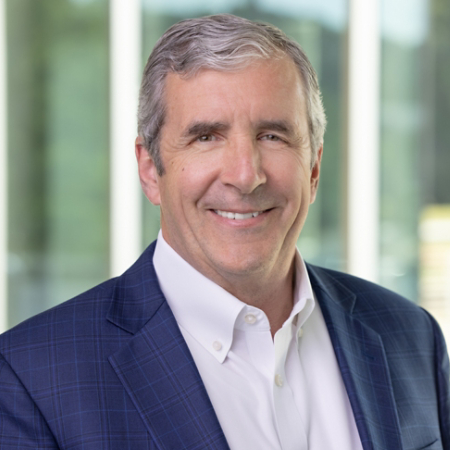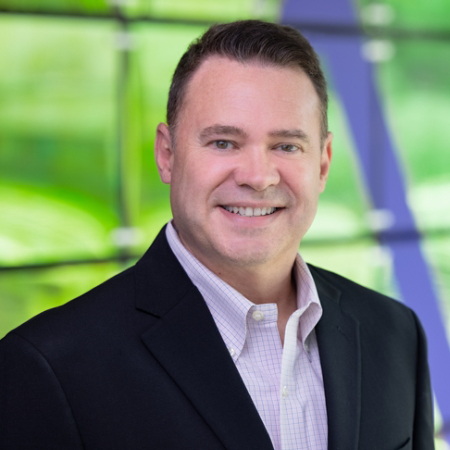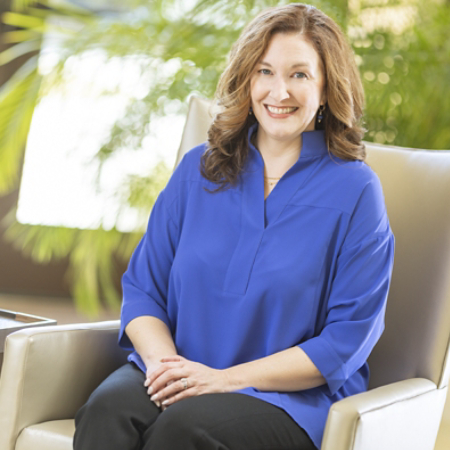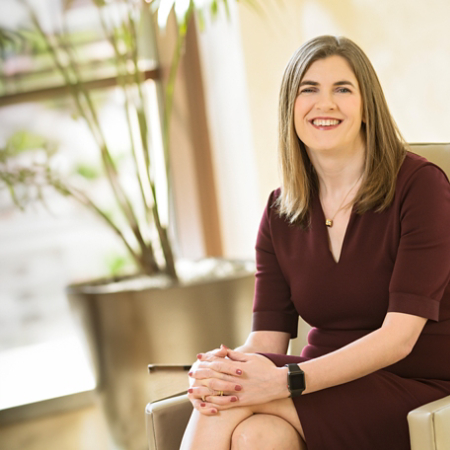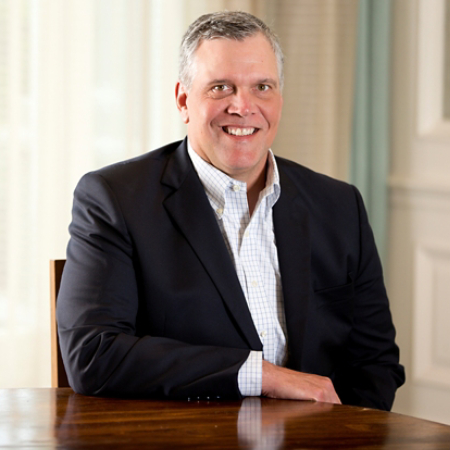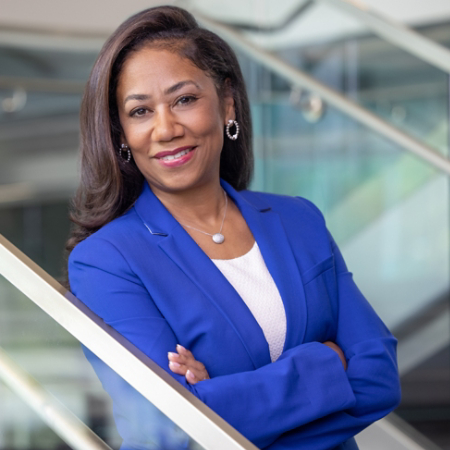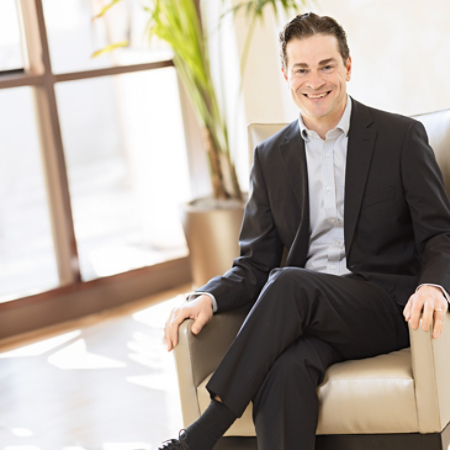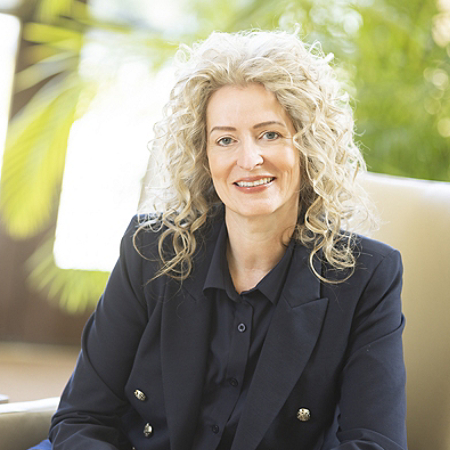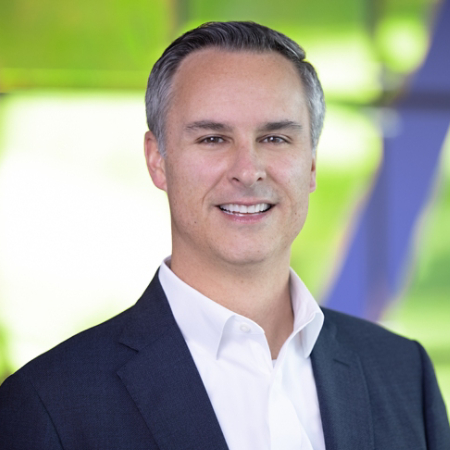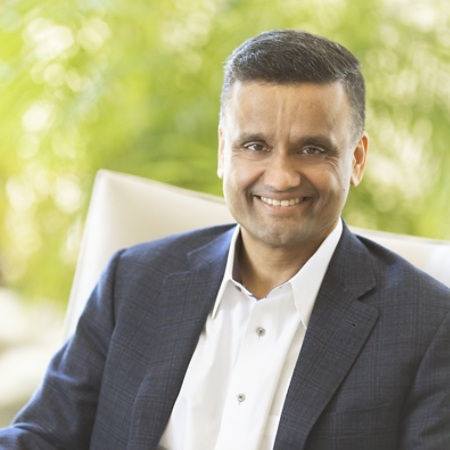[00:00:00] Rasha Hasaneen: So far in the season, we've been talking about the indoor spaces where we work, study and live. Today, I'm excited to talk about the spaces where we play.
[00:00:09] Melanie Koch: I would say indoor environmental quality is top of mind for everyone now for players and performers, for staff, for fans, for attendees. We are more educated as a general public, than we have ever been.
[00:00:22] Rasha: And when we think about what indoor environmental quality is and how it influences occupant experience, the sports and entertainment sector always provides great practical examples.
[00:00:34] Melanie: These are spaces that are meant to feel communal. These are places of gathering. They're meant to be loud. Whether we're screaming in a football stadium, or it's a bustling back of house at a theatre, every element of these performances had to be thought through from a new perspective.
[00:00:53] Rasha: That's Melanie Koch, a once environmental scientist who now serves as a director at the International Well Building Institute. Melanie leads sector development for sports and entertainment, venues, retail, and restaurants, and helps guide WELL's global portfolio of projects as they continue to advance building performance and occupant health.
I'm Rasha Hasaneen and you're listening to Healthy Spaces with Trane Technologies, a series of conversations that explores the world of indoor environmental quality from the inside out.
Whether it's surround sound systems in a cinema, themed lighting in a restaurant, thermal comfort in a concert hall or air quality in athletic training centers, there are so many ways that science is applied to optimize our experience as guests and maximize the performance of athletes and artists. And with Melanie's expertise, no one is better equipped to guide us through the advances in the indoor environmental quality of our leisure spaces. Welcome to the podcast, Melanie.
[00:01:57] Melanie: Thank you. Thanks for having me.
[00:01:58] Rasha: I'm excited to have you here. Let's dive in here. Tell us a little bit about. yourself. I know you come from a background in environmental health sciences. What's been your journey so far. What do you find the most exciting about what your we're doing today?
[00:02:12] Melanie: My background is in public health, specifically environmental health sciences. So, all about the impact that our environmental factors have on our health as people. And to lead to where I am today - we know that our physical and social environments are one of the largest contributors to population health outcomes and that's really what the focus is of what I'm doing in my current role at the International WELL Building Institute. We are promoting health and wellbeing through the places where we spend the majority of our lives inside of our building. And we do that using a tool that we developed called the well building standard.
[00:02:51] Rasha: So, in simple terms, then what exactly is the WELL Building Standard?
[00:02:56] Melanie: The WELL building standard is a framework of health focused strategies for creating, operating, and maintaining spaces over time that support our physical and mental wellbeing. So, I think what's most exciting to answer your question about what I do today is that I get to work directly with our project teams around the globe who are using the WELL Building Standard to improve their buildings and organization. I help them decide which strategies to pursue based on their organization, their goals, their specific population needs their project location and how that might impact their population health concerns. And then as they move forward with implementation, I help them understand how to best achieve those strategies, how to get the most value out of this journey and process and ultimately help them translate and link the science and the evidence behind WELL to their specific project, their building, or their organization.
[00:03:55] Rasha: And it sounds like you get to work with a number of really cool organizations and people. Now IWBI was established in 2013, so that was well before the recent COVID-19 pandemic. And we all kind of know that the pandemic has really accelerated, I would say, the healthy building movement. What changed for IWB I before and after the pandemic?
[00:04:18] Melanie: With the pandemic, there has been rapid acceleration and growth in this movement, but the market awareness was already there even prior to COVID-19 impacting all of our lives. As you said, the WELL Building Standard first launched in pilot in 2013. Flash forward to February of 2020, and there was about 500 million square feet of real estate that had adopted WELL. So that's prior to COVID taking hold in the US. In the past two years, the global adoption of WELL has been exponential. As of today, November in 2021, WELL, is in almost a hundred countries around the world. It's 30,000 locations and covering a well over 3 billion square feet of space.
So, I think the major shifts that we're seeing is that healthier buildings - it used to be a nice to have - and that has changed to being a must. Employees, for example, they're asking their employers, what are you doing to put my health first? You know, what's been done to improve the air quality of this space? What are you doing to encourage people to stay home when they're not feeling well? And so, employers really need to be ready to answer. We've never been so educated as a general population around these topics. and so it's clear to all of us that we need to start thinking about our buildings as a public health tool.
[00:05:44] Rasha: That's fantastic. Now, one of the ways you kind of help achieve that is through the WELL Health Safety Rating. Maybe you can tell us a little bit about that. And what does it tell people about the spaces they're entering?
[00:05:57] Melanie: We stood up a task force on COVID-19 and other respiratory infections. It was co-chaired by renowned experts who represented a wide array of sectors. And throughout the course of this task force, we received overwhelming feedback from the market that there was just so much information out there. And everyone was taking their own approach.
So there was this need for a concise, but also universal framework that would summarize how to get started, which topics needed to be considered and addressed, which solutions could be part of that. And ultimately how we could validate the efforts that all these organizations were going through so that people using these buildings would understand what's been done, and ultimately feel more comfortable going inside. It was really a response to that demand that we developed the WELL Health Safety Rating.
It's focused on operations and policies that organizations can leverage as immediate actions to address health and safety concerns in their spaces. It's something that can get them started right away, but it's also a roadmap so that they can integrate health and wellbeing strategies in a more long-term approach in the future. It focuses on the topics that are most critical in this moment; emergency preparedness, air quality management, health resources, cleaning, and sanitization, stakeholder education and engagement and communication.
And it's this tool that really enables the market to use their buildings as their first line of defense. A large number of global organizations have really jumped onto using this tool to assess their global facility operations, but also assessing and guiding management protocols over time. So, since the launch of the rating in June of 2020, over 23,000 locations have adopted it, which is really exciting. That's about over 2 billion square feet of space.
[00:07:57] Rasha: That's awesome. What a great sort of exponential success for that. And it really gives us, the opportunity to think about how some of these spaces are really stepping up to making sure that occupants are safe and feel safe. Maybe you can talk a little bit about the process that it takes to go through the ratings. How do you decide what good looks like? How do building owners know which path to take?
[00:08:25] Melanie: The WELL Health Safety Rating is made up of 22 health and wellbeing strategies, and they fall across those five topic areas that I mentioned earlier. To achieve the rating, 15 of those strategies need to be met. So there's inherently flexibility in deciding which strategies are most valuable for an organization or for a specific space or building. And there's that flexibility built into the rating to ensure that it can be adaptable to all different types of spaces. So, we're talking about sports and entertainment today, and when you think about a 10,000 seat, concert hall, or a community ice rink, they have really different needs. So, it's a, rating that has really built to be flexible for that. In terms of the process, after the 15 plus strategies are identified, the project team would submit their policies and operations protocols and procedures. They would undergo a third-party review and that's to confirm that those features they are targeting are fully and accurately met. And then at that point, once the third-party review is complete and successful, they would be awarded the WELL Health Safety Rating and can put that seal up at their entrance or on the front door. So that people coming into the space can feel more confident that this space has gone through a rigorous effort to help in this moment,
[00:09:56] Rasha: The efforts required to mitigate indoor environmental quality issues can range from very easy to highly complex. As Melanie pointed out, there are many health and wellbeing strategies out there. That's why it's important to start by assessing what makes the space unique and what IEQ outcomes should be achieved before adopting the best strategy. Similarly at Trane Technologies, we use a framework we like to call, Assess, Mitigate, and Manage, which has helped numerous customers solve their own indoor environmental issues in a range of settings from schools to sports stadiums.
These methods are particularly successful because they aren't one size fits all and take into account each space's unique features and purpose, providing an ongoing framework for improving IEQ as spaces evolve. And it's these bespoke strategies that allowed the WELL Building Institute to help take on some truly enormous challenges - making our indoor sports and entertainment, venues safe in the post pandemic world. These spaces were among the hardest hit by COVID-19. And many of them are still dealing with lower occupancy levels than usual. So, Melanie, what were you hearing from these members and customers as the biggest challenges they were facing?
[00:11:16] Melanie: One of the things we heard from market leaders was they were looking for effective tools to inform and guide their operations so that they could tell their stakeholders that these places have prioritized their health and safety. When COVID-19 first hit us, organizations were looking for a way to understand what needed to be done. And then to validate that what they were doing was the correct approach. So, the sports and live entertainment sector was among the providers of such feedback. And it prompted us to take additional steps and really focus in on this very uniquely impacted sector.
In the summer of 2020, we created the WELL Advisory for Sports and Entertainment Venues. They wanted partnership with both IWBI as a convener, and to provide that third-party validation, which was so critical for them to be the expert on healthy buildings. But they also wanted partnership with other teams and other venues so that they could share best practices, their lessons learned, and they wanted everyone to benefit from their hard work.
I think one of the biggest takeaways for me was the scale of impact and the magnitude of change that was going to be required. One thing that we repeatedly heard was that all elements of a live show and fan experience needed to change. And these are spaces that are meant to feel communal. These are places of gathering. They're meant to be loud, whether we're screaming in a football stadium or it's a bustling back of house at a theatre, every element of these performances had to be thought through from a new perspective. So, it became quite clear that we would need a comprehensive approach and it would need to stay flexible.
[00:13:07] Rasha: Has the pandemic changed how business owners and the sports and entertainment sector perceive indoor environmental quality? And in particular, are we seeing any shifts in sentiment around indoor air quality and its impact on occupant health and safety?
[00:13:26] Melanie: I would say indoor environmental quality is top of mind for everyone now, for players and performers, for staff, for fans, for attendees. We are more educated as a general public than we've ever been.
To give some context through one project example, the Wells Fargo Center is a multipurpose indoor arena in Philadelphia. They recently completed a huge renovation of their HVAC system. They can now complete a full changeover of the air in their arena every 30 minutes, and under ideal conditions down to every 20 minutes. Additionally, at any given time, they're introducing 50% outside, fresh air into their building. But we know that this type of renovation will not be possible for all venues or for all venues at any given time.
And I think the important thing is that focusing on health and safety conditions of venues is on the agenda for all owners and operators. There are immediate measures that they can take and then there are longer-term changes that they can consider and integrate when the time is right later down the road.
[00:14:35] Rasha: And that is so important, Melanie, I think it's fantastic that the Wells Fargo arena was able to upgrade their HVAC system and has the capability to operate that way at this time. And we also know that as it evolves over time, there are real opportunities to balance some of what they're doing with outdoor, fresh air and energy efficiency, and that will manifest itself over time. And so this ongoing annual review of the policies and the strategies become so important as we're expecting to see this focus on indoor environmental quality, but really balanced with energy efficiency and the ability to really manage those operating costs.
Melanie. Those were some really great examples of how some of your partners are thinking about indoor environmental quality. Do you at WELL, have any more examples that our listeners can go look at?
[00:15:34] Melanie: Yes. If you are interested in learning some more about some WELL Health Safety rated projects and hearing their stories and examples of how the process went, I would definitely recommend checking out our website, where we have a number of webcasts and articles available, where we've been sharing these stories.
[00:15:53] Rasha: And you can find the link to all of those in the show notes on your podcast app. As the focus on indoor environmental quality has increased in recent years. The role that science and research has played in developing standards and solutions has never been more important. So, I asked Melanie to talk a little bit about how research and science-based evidence helped to inform the development of the WELL Standard.
[00:16:17] Melanie: The WELL Health Safety Rating is informed by external guidance that's developed by the World Health Organization, for example, the US CDC, Global Disease Control and Prevention Center. It's also informed by standard making bodies, such as ASTN International, ASHRAE. So, we have a dedicated team that focuses on research and on our standard development. And it's this group of experts who develop the features that make up the WELL Building Standard. And their focus is staying up-to-date with the science and the research advancements around their specific dedicated concept areas. And then together with their external team of advisers, keeping the WELL Building Standard, current and updated over time to reflect growing health concerns or the latest research advancements.
[00:17:11] Rasha: I know that we've partnered with IWBI on a number of areas as they relate to indoor air quality in particular. And it's just been great, you know, kind of bringing our experts together with your experts and really exploring what the cutting edge is and where we can really innovate to ensure that the best technologies and the best approaches and strategies are put forward in the standard. So, as entertainment venues start to reopen and then eventually get to full capacity, some of the temporary measures that have been in place like plexiglass walls and sanitation centers are starting to be dismantled. How do you work with an entertainment facility, owner, or a manager to ensure that the investment in occupant health and wellbeing is really more of a longer- term play.
[00:18:02] Melanie: The WELL strategies provide a roadmap and there are strategies that can be met immediately to achieve that rating. But there are also strategies that can be incorporated in the long-term. So, I mentioned that there's an annual renewal. That's a great opportunity to revisit what's most important in that moment. And it's also a really great way to think about preparing for future renovations. It's a roadmap that helps organizations rethink how they want to build a healthier, more resilient future for their organization for crises like we're in now, but also for emergencies in the future. And also just generally focusing on health and wellbeing as a critical topic, as we move forward.
[00:18:46] Rasha: And we know a lot of the strategies that have been put in place for COVID can have an unintended consequence on air. I mean, I was hosting a panel a few weeks ago and we talked about how erecting plexiglass barriers can actually impede the air flow in a space if it's not done properly. So I love the fact that people can, as long as they have their sort of 15 plus strategies, they can mix and match. And if that is what works now, over time, they can abandon a specific strategy in favour of a different strategy, depending on how things evolve.
What's important to remember is that there's no silver bullet to optimize indoor environmental quality. Not only is every space unique in terms of its own physical features, but each space also has its own particular functions and goals. For example, a theme park may want to add odors to enhance guest experience. Whereas other venues need to work hard to remove them.
This summer Trane collaborated with a large casino and resort in California to completely revamp their heating ventilation and air conditioning system. The goal was to improve indoor air quality without compromising energy efficiency. The key challenges with casinos are high levels of tobacco smoke and odor in certain areas. In this particular project that casino utilized a more sophisticated air cleaning technology called dry hydrogen peroxide. DHP is capable of mitigating a broad range of pathogens, including viruses and bacteria, both airborne and on surfaces. And it has been shown to be equally effective in removing odors quickly and safely.
In addition to this and other measures, the casino also invested in air quality monitors and a Trane control system, which not only activates mitigation strategies when required, but also provides occupants information in real time as to whether these strategies are working.
So, as we wrap up our exploration of sports and entertainment venues, I had to ask Melanie, what advice she had for individuals as they start to venture out into those spaces once again.
[00:20:56] Melanie: Well, it's really exciting that we can do that. First of all, I would say, look for the WELL Health Safety Rating seal. Now you know all about what it means and the rigorous process that these locations have gone through. You can understand their third-party review and you can feel more confident going inside.
But really beyond that, I would say to be paying attention and not be afraid to ask questions. Find out what types of measures that space or that organization has taken into consideration. What are they doing to create a healthier environment? How have they addressed those topic areas that we talked about earlier? And I think by asking the questions, the right questions, we're letting them know that we care. So that would be my advice to people is as they start to move about and get back into our public spaces again.
[00:21:43] Rasha: Melanie is so right. As individuals, the best thing we can do for our own health and safety is to look for those certifications and ask what venues are doing to improve their indoor environmental quality. And in order to make their patrons feel safe, the venue owners themselves need to be prepared, which means assessing their situation, implementing mitigation measures and continuously monitoring and managing their solutions.
You've been listening to Healthy Spaces with Trane Technologies. I'm Rasha Hasaneen. For more information on our conversation with Melanie Koch, see the show notes in your podcast app.
We'll be back after a short holiday break and dive into public mass transportation and its role in making cities healthier, more sustainable, and more equitable. Remember to follow us, to hear new episodes.
Thanks for joining us. And we'll see you next time.
